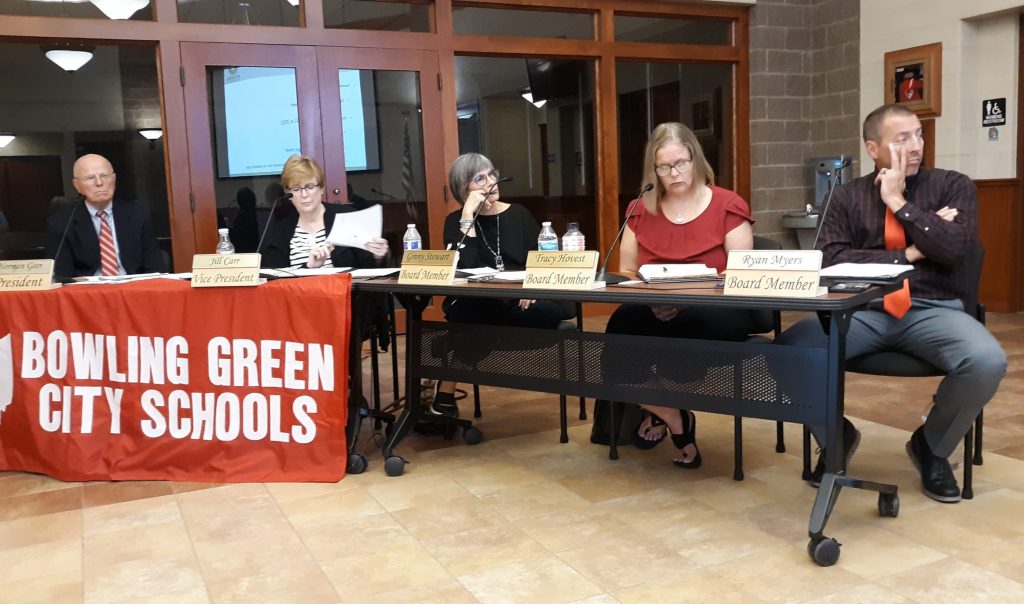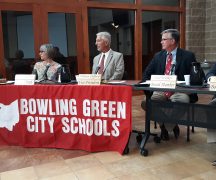By JAN LARSON McLAUGHLIN
BG Independent News
The Bowling Green Board of Education found itself back at a familiar drawing board Thursday evening – again with many moving pieces.
The board talked about finances and facilities – or buildings and the bucks to pay for them. But the plan is different this time around, with the goal to keep all the elementaries, put air conditioning in the two that don’t already have it, and focus on a new high school.
Though no decisions were made, the board appeared to be leaning toward:
- Placing the district’s existing income tax on the November ballot, asking voters to change it from a five-year to a continuing issue. That would allow the district to keep a lower carryover since the $3.8 million from the income tax wouldn’t be in question every five years.
- Putting a building issue on the ballot in May, after spending several months collecting information and input from school staff and community members.
- Coming to a decision on HVAC improvements for Conneaut Elementary, Kenwood Elementary and the high school.
“Seems like we have a lot to think about,” board President Norm Geer said as the board wrapped up its meeting with financial consultant David Conley and school facility experts Dan Obrynba and Tim Hamilton of Fanning Howey.
Clearing the air
The initial dilemma is – should the district put in less expensive mini-split air conditioning systems that will make the buildings comfortable, or invest more for ducted systems that also provide safer air quality? The more costly option, which would be about $2.5 million, has a better chance of being approved for federal funding by the Elementary & Secondary School Emergency Relief Fund.
But, does the school district want to invest $2.5 million in HVAC systems if there is a chance that voters in the not too distant future would approve building new elementaries?
The school board shared concerns about air quality – especially after this year of COVID.

“Ventilation is a real concern,” Geer said.
Board member Tracy Hovest agreed. “We can’t just make it comfortable,” she said.
Board member Ginny Stewart also questioned if the district should be investing in a system that doesn’t improve air quality.
“Is that acceptable given what we’ve just been through?” Stewart asked.
Another consideration is the fact that the better system would take longer to install. The mini-splits might be able to be phased in and be completed by spring, Obrynba said. But the ducted system would not be able to be installed until next summer.
Stewart expressed concerns about fixing the HVAC at the elementaries, but not bringing the school buildings “into this century.”
“It’s not moving you into 21st century schools by any means,” Obrynba said. He suggested the district “look at those buildings that you know are long-term buildings and invest in them.”
Vision for buildings
Another big issue faced by the board and the community is determining the vision for the district’s facilities. Fanning Howey has worked with 190 Ohio school districts to design buildings, including at Perrysburg, Eastwood, North Baltimore and Northwood in Wood County.
Obrynba said the firm will study the building conditions, the enrollment and educational visioning – such as determining if the district wants its buildings to be more student centered.
“How are you teaching today? How do you want to teach tomorrow? Is the building getting in the way?” he asked.
The visioning process looks beyond “if it was good enough for me … it’s good enough for kids today,” Obrynba said.
Fanning Howey believes education isn’t just the three “Rs,” but also several “Cs” for creativity, collaboration, critical thinking, character, communication, community and citizenship.
To determine what the community wants, the study process will begin by collecting information. A small advisory group would be created to include the superintendent, one or two board members, facilities director, treasurer, and one or two community leaders.
From there, a bigger group of 40 to 80 people will be formed. That group will be made of district employees, parents, community leaders and business leaders. The group will tour facilities, plus rank needs and obstacles.
Open community meetings will also be scheduled.
“What you’re trying to do through this process is create ownership in the community,” Obrynba said.
Obrynba suggested the “visioning” process begins by September, so a building issue could be on the ballot next May.
“It will get the staff excited, too. They want to have that conversation. They want someone to hear them,” he said.
Continuing income tax
In order to change the district’s last five-year tax issue to a continuing levy, Conley suggested that the board put its income tax on the ballot in November. The voters already converted two other five-year issues to continuing – and if they approved this last one, it would mean the district could carry a lower balance and make better use of the funding.
Income taxes can only be placed on May and November ballots, so the district has three chances before it expires, Conley said.
“The community seems to understand the concept” but changing the levy to “continuing” does raise the risk of it not passing, he said.
“If we miss November, our back is against the wall,” he said.





